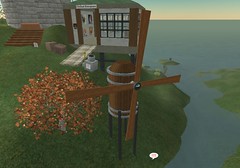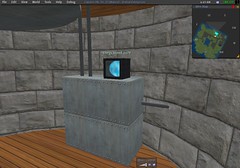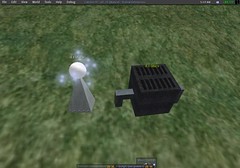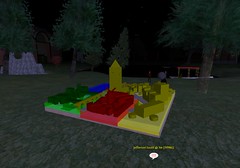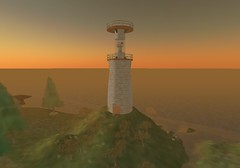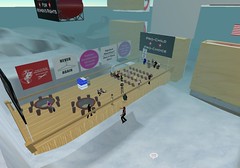The uselessness of frames; a cathedral of sorts
One can find these items, as well as the battery, in the Engine Room at the Caledon Lighthouse. Please feel free to take a copy for your own examination. At the base of the lighthouse is a transit chair to take one directly there - one can also fly upwards, should one not have a great sensitivity to banging one's head.
A couple of other things of minor note: a neighbour of mine in Theretra very kindly offered to swap her plot (which was right in the middle of my other land) for a part of mine next door to it, which was advantageous for the both of us; I now have a large, continuous piece of land, and she is right next door to her friends without my firing range getting in the way.
I was not too sure as to what I was going to do with the increased area. I did have an idea concerning a ruined "steampunk cathedral", but a problem one faces when constructing things out of geometric primitives is that it is hard to actually make rubble without it involving a vast number of them - and so in the end, I simply built a sort of non-ruined cathedral.
It doesn't look terribly like a cathedral from the outside at the moment - I would like gargoyles and similar flim-flammery, and more rivets are clearly required - but I am running out of prims I'm afraid, and I do actually wish to put some objects inside it as well. Inside, it does, at least a little more. My plan, vague as it is at the moment, is to incorporate much in the way of gears and machinery, and also a miniature museum of computational history. (I'd like to build an Enigma machine in LSL, for a start.) It may, however, be a little blocky in appearance.
This would all be a lot easier were the land next to me not apparently Linden-owned, but set to sell to only one person. Dash it. There are several plots in that state nearby and, while on one hand I relish the peace of empty plots and dread the appearance of some appalling casino or other lag establishment, on the other, if I wish to extend myself I need to be able to actually buy these things. I could purchase random plots around Theretra simply for their prim allowance, but I would prefer to have continuous land, as stated above.
If only my prim mine did not simply distribute prims to other parts of the grid, but rather allowed me to keep them. I should really have thought of that, I now see.
Ah. Yes. One final point. I did also speak with a gentleman on Sunday who was interested in my Touring Dirigible script, visible in Caledon at the moment. I promised to inform him when said work was publicly released, only, rather predictably, I failed to take his name down. I do most humbly apologise and would ask him, if he is reading this particular piece, to contact me forthwith. 'Tis not actually publicly released as yet, but likely will be shortly, as soon as I decide on a price and arrangement for it. Clearly it should be copiable, as vehicles are prone to all sorts of mishaps, but on the other hand, should the smallholder wishing a brief tour of his or her land pay the same as the landowner using it for ferry tours across multiple sims?
Oh, Second Life is too short to worry about such stuff. I shall just pick a sum and sell at that.
